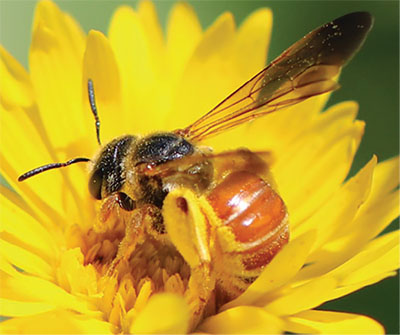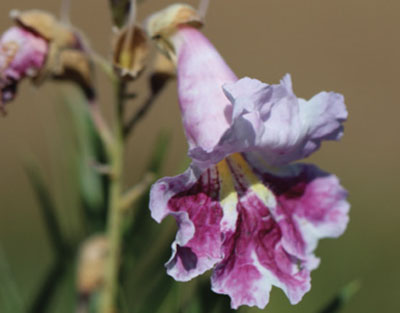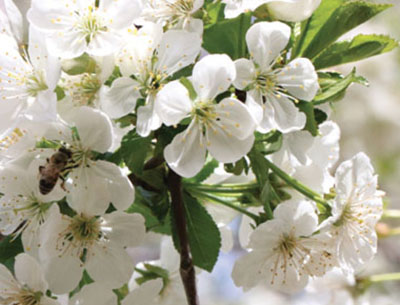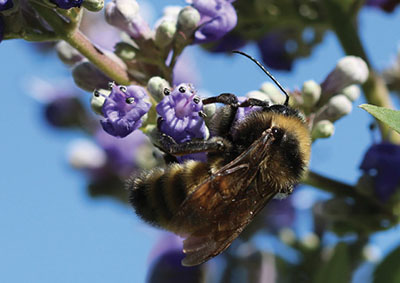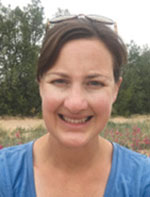Guide H-177
Miranda L. Kersten, Alissa J. Freeman, Amanda R. Skidmore, and Marisa Y. Thompson
College of Agricultural, Consumer and Environmental Sciences, New Mexico State University
Authors: Respectively, Program Manager, Agricultural Science Center at Los Lunas; Former Senior Program Specialist, Agricultural Science Center at Los Lunas; Former Extension Integrated Pest Management Specialist, Department of Extension Plant Sciences; Extension Urban Horticulture Specialist, Department of Extension Plant Sciences. (Print Friendly PDF)
Developing a habitat to provide resources for beneficial insects and other arthropods (pollinators and natural enemies) is an excellent way for homeowners and landscape managers to support a healthy urban ecosystem. Trees and shrubs are an important resource for beneficial arthropods in urban areas; they can supply pollen, nectar, and shelter year-round. Understanding the seasonal life cycle of trees can aid with providing resources throughout the year. Trees and shrubs that flower in the early spring provide invaluable food sources for early emerging pollinators, while late-blooming plants provide valuable resources for overwintering arthropods. Trees and shrubs—both dead and alive—also provide nesting and overwintering habitat for many pollinators and natural enemies.
(Cover photo of a bee collecting pollen by Ashley B. Bennett.)
Flower size, shape, and aroma influence pollinator attractiveness (Figures 1–4). Trees and shrubs with showy, colorful, and fragrant flowers are typically pollinated by insects and other animals, while plants with inconspicuous flowers are often wind-pollinated. Flowers provide both nectar and pollen—important food resources for pollinators. Wind-pollinated trees can provide supplemental pollen resources for bees, especially in the spring. Other bees, particularly several species of leafcutter bees (family Megachilidae), collect plant resin and pine sap from wind-pollinated trees and other plants to help create their nests. Wind-pollinated trees also provide many ecological functions, such as serving as larval host plants for butterflies and moths, providing nesting sites, and providing food sources for birds and mammals.
Figure 1. Butterflies, bumble bees, and hummingbirds are frequent visitors to trumpet-shaped flowers. (Photo by Miranda L. Kersten, NMSU.)
Figure 2. Many pollinators and predatory insects are associated with bowl-shaped flowers. (Photo by Miranda L. Kersten, NMSU.)
Figure 3. Plants in the Asteraceae family are characterized by composite or disk-shaped flowers. These flowers are popular with bees, butterflies, and predatory insects. (Photo by Miranda L. Kersten, NMSU.)
Figure 4. Funnel-shaped flowers support many insects and birds. (Photo by Miranda L. Kersten, NMSU.)
In addition to providing food and habitat resources, consider how pest management practices may affect beneficial arthropods. For example, if you choose to use a pesticide to manage pests in your landscape, it is important to consider the timing of any application. Avoid spraying blooming trees and shrubs, if possible, to reduce exposure to foraging insects. Scout plants for blooming flowers and beneficial insects before spraying, and look for products that have less of a toxic effect on non-target insects.
Typically, pollinators prefer to forage on nectar and pollen from a single plant species, making trees with an abundance of flowers especially attractive to pollinators. When selecting a tree for your landscape, consider if and how it will support beneficial insects. Native tree and shrub species are important to incorporate into your landscape. Native beneficial arthropods are often specialists of native plants found in their geographic area; therefore, planting native species can help support their populations. Native plant species are often hardier and better adapted to the local climate. Table 1 provides a list of native and ornamental trees and shrubs and examples of the pollinators and natural enemies that they can benefit. By providing nesting habitat and floral resources in the landscape throughout the seasons, you can encourage beneficial insect populations in your home or greenspace and help to support their populations.
| Table 1. Examples of Trees and Shrubs for Beneficial Insects | |||||||
| Name | Family | Status | Plant Height | Flower Color | Flower Shape | Flowering Season | Benefits |
|
Apache plume (Fallugia paradoxa) |
Rosaceae (Rose Family) |
Native |
2–6 ft (0.6–2 m) |
White |
Disk |
Summer |
Small bees, green bees, large bees, large wasps |
|
Apples, including crabapples |
Rosaceae (Rose Family) |
Ornamental |
15–25 ft (4.5–7.6 m) |
White to red |
Bowl |
Late spring |
Honey bees, small bees, large bees, green bees, bumble bees |
|
Apricots, cherries, peaches, plums (Prunus spp.) |
Rosaceae (Rose Family) |
Native/Fruit |
10–20 ft (3–6 m) |
White, pink |
Bowl |
Spring |
Bumble bees, small bees, large bees, honey bees, syrphid flies, wasps, butterflies |
|
Baccharis (Baccharis spp.) |
Asteraceae (Aster Family) |
Native |
Up to 10 ft (3 m) |
White, yellow |
Disk |
Fall |
Honey bees, small bees, large bees, large wasps, syrphid flies, butterflies |
|
Catalpa (Catalpa speciosa) |
Bignoniaceae (Catalpa Family) |
Native |
Up to 40 ft (12 m) |
White |
Funnel |
Spring |
Bumble bees, large bees, honey bees |
|
Chaste tree (Vitex agnus-castus) |
Verbenaceae (Verbena Family) |
Ornamental |
8–10 ft (2.4–3 m) |
White, pink, lilac |
Funnel |
Summer to early fall |
Large bees, bumble bees, honey bees, butterflies |
|
Crape myrtle (Lagerstroemia indica) |
Lythraceae (Loosestrife Family) |
Ornamental |
8–30 ft (2.4–9 m) |
White, pink, red, purple |
Cruciate (four-petaled, cross-like) |
Summer |
Honey bees, green bees, large wasps |
|
Desert willow (Chilopsis linearis) |
Bignoniaceae (Catalpa Family) |
Native |
12–40 ft (3.6–12 m) |
White, pink, purple |
Trumpet |
Summer to fall |
Large bees, small bees, bumble bees, small wasps, large wasps, hummingbirds |
|
Eastern redbud (Cercis canadensis) |
Fabaceae |
Native |
Up to 13 ft (4 m) |
Magenta, purple-pink |
Papilionaceous (resembling a butterfly; characteristic of the legume family) |
Spring |
Bumble bees, small bees, large bees, butterflies, syrphid flies, wasps |
|
False indigo (Amorphafruticosa) |
Fabaceae |
Native |
Up to 6 ft (2 m) |
Purple |
Tubular |
Late spring to early summer |
Small bees, butterflies |
|
Golden currant (Ribes aureum) |
Grossulariaceae (Gooseberry Family) |
Native |
Up to 6 ft (2 m) |
Yellow |
Tubular |
Spring |
Bumble bees, large bees, small bees, honey bees, butterflies, hummingbirds |
|
Goldenrain tree (Koelreuteria paniculata) |
Sapindaceae (Soapberry Family) |
Ornamental |
Up to 30 ft (9 m) |
Yellow |
Rotate (wheel-like, with separate, unfused petals) |
Late spring to summer |
Bumble bees, honey bees, small bees, large bees |
|
Honey mesquite (Prosopis glandulosa) |
Fabaceae (Legume Family) |
Native |
Up to 10 ft (3 m) |
Yellow |
Bowl |
Spring to fall |
Small bees, honey bees, |
|
Jujube (Ziziphus jujuba) |
Rhamnaceae (Buckthorn Family) |
Fruit |
15–30 ft (4.5–9 m) |
White to light green |
Rotate |
Summer |
Syrphid flies, large wasps |
|
Littleleaf sumac (Rhus microphylla) |
Anacardiaceae (Sumac Family) |
Native |
6–12 ft (2–3.6 m) |
White |
Rotate |
Spring |
Small bees |
|
Mexican elder (Sambucus mexicana) |
Caprifoliaceae (Honeysuckle Family) |
Native |
Up to 26 ft (8 m) |
White |
Rotate |
Spring to fall |
Small bees, butterflies |
|
New Mexican locust (Robinia neomexicana) |
Fabaceae (Legume |
Native |
Up to 26 ft (8 m) |
Pink, purple |
Papilionaceous |
Summer |
Bumble bees, hummingbirds, butterflies |
|
New Mexico olive (Forestiera neomexicana) |
Oleaceae (Olive Family) |
Native |
3–10 ft (1–3 m) |
Green |
Bowl |
Spring |
Honey bees, native bees, lady beetles |
|
Texas mountain laurel (Sophora secundiflora) |
Fabaceae (Legume Family) |
Native |
10–20 ft (3–6 m) |
Blue, purple |
Papilionaceous |
Spring |
Honey bees, small bees, butterflies |
|
Texas red yucca (Hesperaloe parviflora) |
Asparagaceae (Asparagus Family) |
Native |
Up to 5 ft (1.5 m) |
Red |
Bell |
Summer |
Hummingbirds, butterflies, honey bees |
|
Yellow rabbitbrush (Chrysothamnus viscidiflorus) |
Asteraceae (Aster Family) |
Native |
Up to 5 ft (1.5 m) |
Yellow |
Disk |
Late |
Bumble bees, small bees, large bees, lady bugs, green bees |
For more information on plants and beneficial insects, check out these resources:
Donkersley, P. 2019. Trees for bees. Agriculture, Ecosystems & Environment, 270–271, 79–83. Available online at https://doi.org/10.1016/j.agee.2018.10.024
Dreesen, D.D., and T.R. Grasswitz. 2015. Pollinator plant recommendations for New Mexico [NRCS Plant Materials Center Technical Note No. 71]. Available online at https://www.nrcs.usda.gov/Internet/FSE_PLANTMATERIALS/publications/nmpmctn12632.pdf
Holm, H. 2017. Bees: An identification and native plant forage guide. Minnetonka, MN: Pollination Press, LLC.
Mach, B.M., and D.A. Potter. 2018, December 26. Quantifying bee assemblages and attractiveness of flowering woody landscape plants for urban pollinator conservation. PLOS ONE. Available online at https://doi.org/10.1371/journal.pone.0208428
Pollinator Partnership. n.d. Selecting plants for pollinators: A regional guide for farmers, land managers, and gardeners in the intermountain semidesert province. Available online at https://www.pollinator.org/PDFs/IntermtSemidesrt342.rx2.pdf
St. Hilaire, R. 2018. Landscape plants for the lower Rio Grande Basin. Austin: Sentia Publishing.
This work is supported by the Crop Protection and Pest Management Program [grant no. 2017-70006-27189] project accession no. 1013838 from the National Institute of Food and Agriculture.
For Further Reading
H-169: Using Insectary Plants to Attract and Sustain Beneficial Insects for Biological Pest Control
https://pubs.nmsu.edu/_h/H169/
H-172: Backyard Beneficial Insects in New Mexico
https://pubs.nmsu.edu/_h/H172/
H-174: Integrated Pest Management (IPM) Strategies for Common Insect Pests of Trees in New Mexico
https://pubs.nmsu.edu/_h/H174/
Miranda Kersten is a Senior Program Specialist with the urban integrated pest management (IPM) program at NMSU’s Agricultural Science Center in Los Lunas. Her work focuses on pollinator and beneficial insect conservation, monitoring beneficial insects across urban landscapes, and managing IPM research projects.
To find more resources for your business, home, or family, visit the College of Agricultural, Consumer and Environmental Sciences on the World Wide Web at pubs.nmsu.edu.
Contents of publications may be freely reproduced, with an appropriate citation, for educational purposes. All other rights reserved. For permission to use publications for other purposes, contact pubs@nmsu.edu or the authors listed on the publication.
New Mexico State University is an equal opportunity/affirmative action employer and educator. NMSU and the U.S. Department of Agriculture cooperating.
August 2021, Las Cruces, NM


